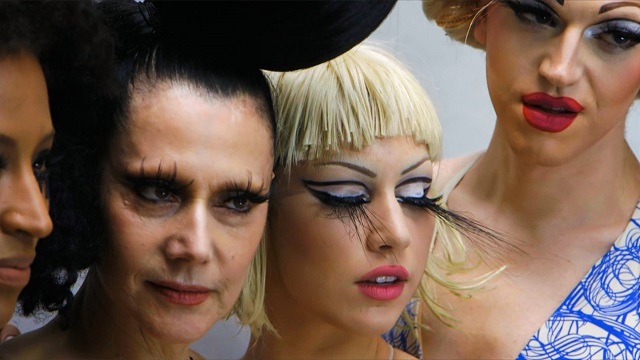What happens when somebody makes a perfectly lovely documentary but you couldn’t care less about the subject? Susanne Bartsch is a New York club night planner. Originally from Switzerland, this outrageous woman threw regular New York parties, becoming an icon of the 1980s Club Kid scene. She married David Barton (of David Barton Gyms), and continued being a mother to the most outrageous of the gay kids and…I mean, I wish I cared more about this.
Listen, this is the wholesome heterosexual version of Party Monster. Where Michael Alig cared nothing about anybody except for himself, Susanne Bartsch took people under her wings and threw huge galas for AIDS charities (one of which features the ball queens from Paris Is Burning). Where Alig actually killed somebody over drugs, Ms. Bartsch got married and had a child. Basically, if you want all of the outrageousness of the New York club kid scene without any of the residual ickiness, guilt, or negativity that results when a movie worships a murderer, perhaps Susanne Bartsch: On Top is going to be more your speed. But, from the standpoint of 2017, all I could see was a bunch of fiddle playing while New York burned.
This year, we’re about 30 years out from the start of the post-Warhol celebutante club kid scene (Warhol died 30 years ago last February). We’re also 28 years out from the end of Reagan’s regime. And…I dunno. I just…back when Party Monster: The Shockumentary came out in 1998, we were at the height of our economic bubble under Clinton, and it was hip to fetishize the club kid scene while also acknowledging that it was probably fueled by drugs and narcissism. Even the fictionalized movie Party Monster mixed the knowledge that the club kid scene was self-actuating for a bullied subculture and the self-critical realization that there was a hefty amount of chemically-induced monstrous egocentrism that made up a core of the scene.
Susanne Bartsch: On Top only lets the egomania of the scene peek around the edges (as when Bartsch name drops all of the celebrities at one of her balls), but paints a loving portrait of a fashion icon who carved a niche in a scene even through her tumultuous on-off marriage. She has a separate apartment to hold all of her costumes, never acknowledging that something like that creates housing scarcity. But, at least she saved them because her outrageous style earned her a 2015 exhibit of her clothing at New York’s Fashion Institute of Technology (which was the impetus for this documentary). And yet, the documentary is wholly uncritical of this extravagant lifestyle and of the excess that it represents.
Maybe it just came out in the wrong year. 2016 and 2017 seem like the worst political climate to have a documentary that lovingly gazes at capitalist excess and a party scene, regardless of the one AIDS charity event and the loving inclusion of the maybe not-wealthy gays who participate in her parties. Maybe if we were sitting in the comfort of a climate where we were all more economically and politically secure in our past and future, this would be a fine peek into big city life for people who couldn’t manage to survive there. Maybe I would have loved this film 15 years ago. I probably would have, actually. But, right now, this movie just filled me with the feeling of “who cares?” And, if you do, you should go see it because this is a well-constructed film otherwise (full of home footage and naked David Barton). For me, it’s the wrong film at the wrong time.

